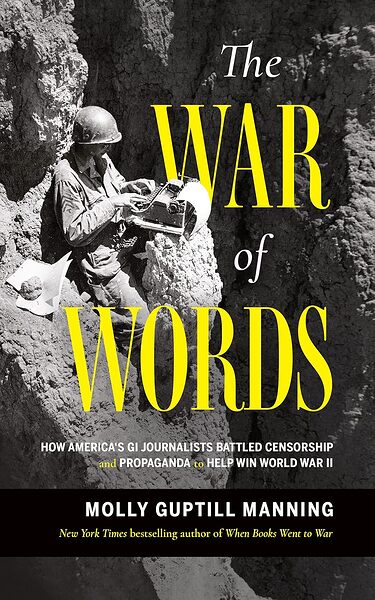Looking for a good read? Here is a recommendation. I have an unusual approach to reviewing books. I review books I feel merit a review. Each review is an opportunity to recommend a book. If I do not think a book is worth reading, I find another book to review. You do not have to agree with everything every author has written (I do not), but the fiction I review is entertaining (and often thought-provoking) and the non-fiction contain ideas worth reading.
Book Review
A GI View of the News
Reviewed by Mark Lardas
November 5, 2023
“The War of Words: How America’s GI Journalists Battled Censorship and Propaganda to Help Win World War II,” by Molly Guptil Manning, Blackstone Publishing, 2023, 274 pages, $25.99 (hardcover), $9.99 (e-book), $36.95 (audio CD)
When World War II started newspapers and magazines were at a zenith in American culture. US military leaders, including George C. Marshall, decided the Army needed its own newspapers and magazines to inform troops. Surprisingly, they gave the GIs running the publications a remarkable freedom to report as they saw fit.
“The War of Words: How America’s GI Journalists Battled Censorship and Propaganda to Help Win World War II,” by Molly Guptil Manning, tells the story of the GI press in World War II. It shows they were a weapon leading to US victory as much as the tanks and artillery wielded by the GIs.
Manning makes Marshall the champion of the GI newspaper. She also shows why. Marshall understood morale’s importance. He believed keeping GIs uninformed, with no place to gripe, contributed to low morale. The book shows how and why Roosevelt supported Marshall. She shows how the Nazis harnessed propaganda to further their efforts. Marshall and Roosevelt believed a patriotic free press within the US military would counter that.
By war’s end over 4600 separate GI periodicals appeared, including newspapers and magazines published at the post, divisional, and theater level. Some, like Stars and Stripes and Airman, had world-wide reach. Others like the Camp Bowie Blade were strictly local. A few, like 45th Division News, had tremendous impact. Famed war cartoonist Bill Mauldin started out there.
Manning shows the correspondents at work, occasionally under fire, to gather news and write it up for their publications. Some were newspapermen before the war, willing to ply their prewar trade along their GI responsibilities. Others, like Andy Rooney, picked up reporting in the army and continued in civilian life.
Manning traces the effects of these publications on the men who fought in World War II. She uncovers the effort required to produce them. It required a massive allocation of paper and ink. Printing presses and reproduction equipment had to be secured and shipped. She also shows the varying levels of support offered by different commanders. General Eisenhower favored the papers and gave those under his command wide press freedom. General McArthur disliked giving GIs any latitude to print anything at variance with McArthur’s view of what should be said.
“The War of Words” is a fascinating look at the US press and US military during World War II. It focuses attention on an overlooked aspect of the US military in that war.
Mark Lardas, an engineer, freelance writer, historian, and model-maker, lives in League City. His website is marklardas.com.
